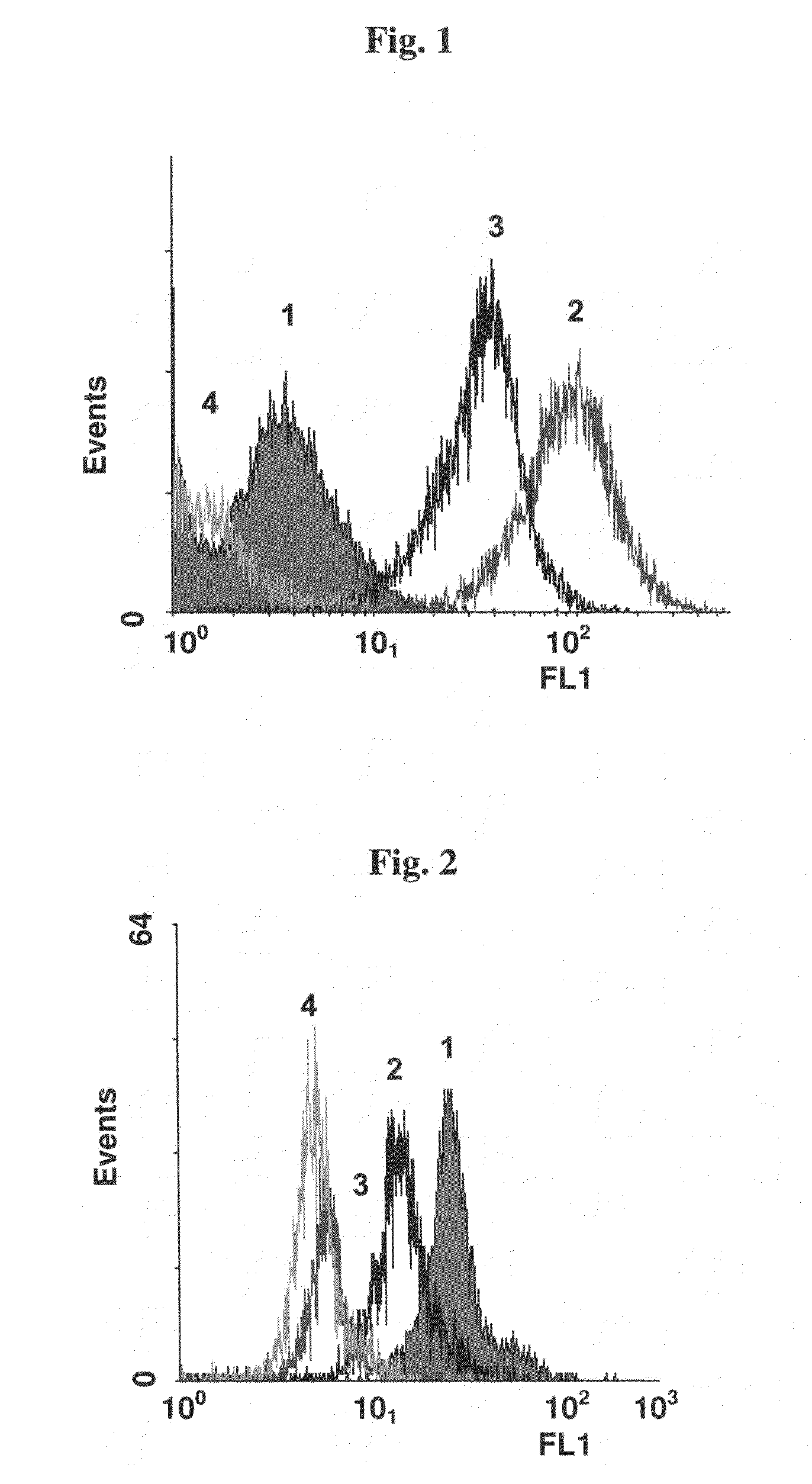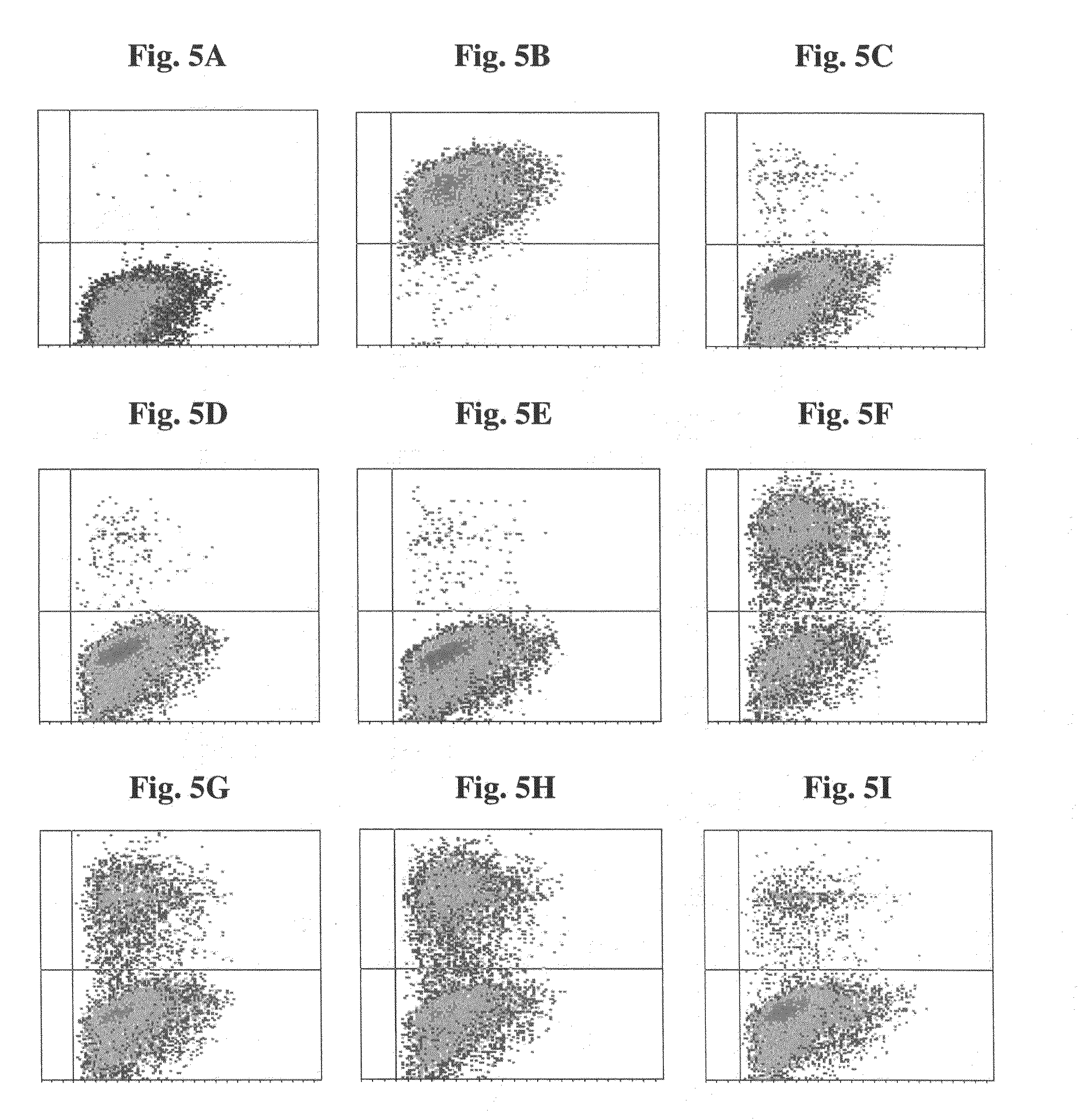Targeting of innate immune response to tumor site
- Summary
- Abstract
- Description
- Claims
- Application Information
AI Technical Summary
Problems solved by technology
Method used
Image
Examples
example 1
Production of Microbeads Carrying Anti-HER2 mAb and LPS
(i) Binding of Antibodies to Avidin-coated Beads
[0099]Monoclonal anti-HER2 antibody (anti-HER2, Herceptin) was biotinylated using the Sulfo-NHS-LC-Biotin kit (Pierce) according to the manufacturer's instructions. Biotinylation rate was determined by HABA test (Acros, USA) according to the manufacturer's instructions. The ability of the biotinylated mAb (Biot-anti-HER2) to detect HER2 was examined by incubation with target cells (SK-BR-3 human breast cancer cells expressing HER2, ATCC) that were stained with STAVF (streptavidin-FITC, Jackson ImmunoResearch). Incubated samples were then examined using Flow Cytometry (FACS). FIG. 1 demonstrates binding of the biotinylated mAb Biot-anti HER2 to SK-BR-3 cells (HER2 positive).
(ii) Biotinylation of Lipopolysaccharide (LPS) [SUPPLIER]
[0100]LPS (Sigma L2654) was biotinylated (Biot-LPS) using biotin hydrazide (Pierce) according to the manufacturer's instructions. Biotinylation efficiency ...
example 2
Binding of Microbeads Carrying Anti-HER2 and LPS to SK-BR-3 Cells
[0102](a) Mixtures of biot-anti-HER2 and biot-LPS, at various ratios, were attached to fluorescent polystyrene beads 2 μm in diameter (F-Beads) (Fluoresbrite YG Polysciences) or Biomag™ particles (approximately 1.5 μm) (Pierce) covalently coated with avidin, and the beads were incubated with SK-BR-3 cells. Samples were fluorescently stained with goat anti human Fc-FITC Abs and examined by FACS. Both Biomag™ particles (FIGS. 3 and 4) and F-Beads complexes (FIG. 5) demonstrated ability to bind SK-BR-3 target cells when anti-HER2 mAbs were attached to them.
[0103](b) SK-BR-3 cells were incubated overnight in 24-well plates. Biomag™ particles of (a) were added and incubated for one hour, followed by two washes. Samples were fluorescently stained with goat anti-human Fc-FITC for one hour, followed by two washes. Microbeads carrying anti-HER2 mAb and LPS attached to cells were detected by fluorescence microscope. FIG. 6 shows...
example 3
THP-1 Monocytes Response to Beads Carrying Anti-HER2 mAb and LPS
(i) Induction of Uptake
[0105]Human monocytic THP-1 cells (ATCC) were incubated overnight in 24-well plates. Ten-μm polystyrene beads carrying anti-HER2 mAb and LPS particles were added and incubated for 3 hours. FIG. 8 shows the uptake of the 10 μm polystyrene beads by THP-1 monocytes.
(ii) Induction of IL-1 Transcription
[0106]THP-1 cells were incubated overnight in 6-well plates. Biomag™ particles carrying anti-HER2 mAb and LPS were added and incubated for 3 hours. Growth medium was discarded. Cells were centrifuged, RNA was extracted using trisol reagent (Sigma). RT-PCR reaction (Promega kit) was performed using Oligo dT primers (Sigma), and the resulted cDNA was used in PCR reaction (Bioline kit) to propagate the IL-1 gene product. The PCR product was run on agarose gel and compared to GAPDH (glyceraldehyde-3-phosphate dehydrogenase, a constitutively expressed gene). DNA was stained with ethidium bromide. Analysis of ...
PUM
| Property | Measurement | Unit |
|---|---|---|
| Size | aaaaa | aaaaa |
| Size | aaaaa | aaaaa |
Abstract
Description
Claims
Application Information
 Login to View More
Login to View More - R&D
- Intellectual Property
- Life Sciences
- Materials
- Tech Scout
- Unparalleled Data Quality
- Higher Quality Content
- 60% Fewer Hallucinations
Browse by: Latest US Patents, China's latest patents, Technical Efficacy Thesaurus, Application Domain, Technology Topic, Popular Technical Reports.
© 2025 PatSnap. All rights reserved.Legal|Privacy policy|Modern Slavery Act Transparency Statement|Sitemap|About US| Contact US: help@patsnap.com



